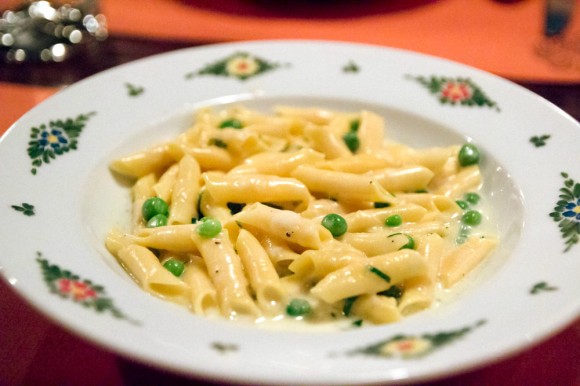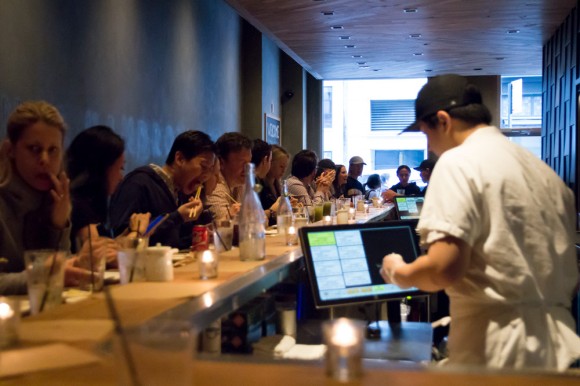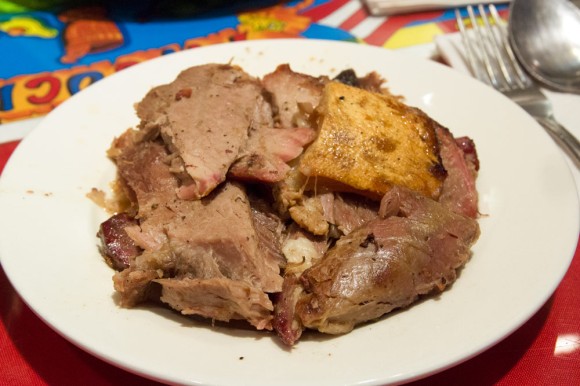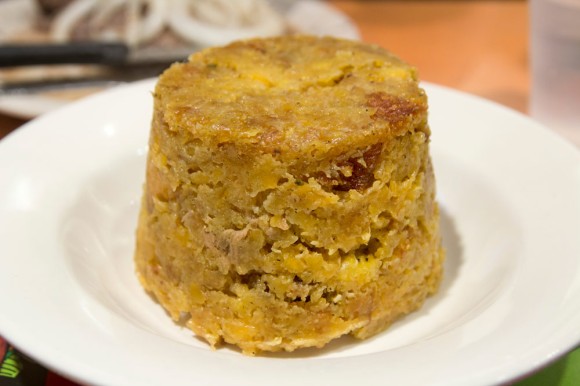
I like bright, open spaces. Lots of windows. Modern, minimalist decor—clean lines and simple shapes. I don’t like clutter. I don’t like congestion. I don’t like to eat in the dark. I don’t like to eat in the loud. I don’t like yelling over music, and I certainly don’t like yelling over drunk people. (Basically, I don’t like restaurants From The People That Brought You Hollister.) And I hate kitsch, too: sports memorabilia, autographs, dream-catchers—whatever the breed, it probably offends me. Call me picky, or something worse. Fact is, I hate the vast majority of bars.
So it’s a little strange, I guess, that I can tolerate Wogies, a bar’d-out, sports’d up sports bar with two locations in lower Manhattan. It’s tight, and it’s dark, and it’s packed with flatscreens and Eagles fans—but the food’s all right, and some of it’s actually sort of good, and only one dish (a dessert) has nuts in it. Everything else is safe, including the bread, which is made in house, and which has virtually no chance of having come into contact with nuts of any sort. As you all probably already know, I’ll go just about anywhere for a safe sandwich. What’s a night at a nearby sports bar, then? And a sports bar with outdoor seating, at that—which means that with a little creative positioning, I hardly have to acknowledge I’m at Wogies at all.
Now, I have absolutely no problem with blocking out my surroundings in the name of good food. I’ll happily shut down my senses of sight and hearing (and annoyance, my ever-important sixth) and just double down on smell and taste for the evening, provided, of course, that the smells and tastes I’m signing up for can stand up to that sort of focus. But the situation at Wogies isn’t quite so simple. Their dishes—or those I’ve selected to try, at least—fall into three categories: the kinda-bad, the just-okay, and the actually-kinda-good. That last category’s definitely real enough to keep me coming back. But…I don’t know.

Most of the menu is made up of sandwiches: a few Philly cheesesteaks, and bunch more “Wogies originals.” There are wings and sides, too, but since the cheesesteaks are clearly, you know, the point, I figured I’d start with those. So my first time at Wogies, I ordered their standard cheesesteak: “seasoned steak,” grilled onions, and provolone (which I chose over American and the unpardonable monster that is Cheez Whiz), all wedged into a homemade Wogies roll. But despite how ready I was to like that thing, I just couldn’t. The steak, though plenty soft in texture, tasted tough. No, I’m not sure how that’s possible. I’m not even sure what it means. I guess it was the seasoning—too strong, kind of funky. Beyond these, I don’t have the words. But I didn’t like it, and I couldn’t ignore it.
No big deal. I figured I’d just stay away from the more steak-forward sandwiches. But that didn’t quite solve the problem. The chicken cheesesteak—same as the standard, but with marinated chicken breast in place of seasoned steak—was effectively the same as the one made with beef. And the “pizza steak,” also the same as the standard, but smothered in marinara, and with mozzarella and parmesan instead of provolone, is disappointing as well. I prefer it to the cheesesteaks, but only because the marinara covers the flavor of the meat. Far from good, it’s intensely wet and soggy—and though that marinara’s doing the Lord’s work, it’s not like it’s particularly engaging, taste-wise. It’s flat and boring, and the sheer amount of it guarantees a one-note sandwich.
All that suffering, and then a realization: Wogies offers two kinds of beef—not for you to choose from, cheese-style, within a given sandwich, but across their selection of sandwiches, at least. There’s “seasoned steak,” which term the menu uses to refer to the grublike chunks of steak with the funky flavor I half-described above, and then there’s “house-seasoned chopped steak,” which evidently signifies something else entirely: not chunks, but strips—ribbons, even, layered side by side (by side, by side) to form one tender, textured whole, entirely without the funk of the chunks. To my delight, the sandwiches made with the chopped steak…are actually pretty good.
One of those sandwiches, the cheeseburger hoagie (just what the name implies: a roll stuffed with steak, bacon, cheddar, grilled onions, lettuce, and tomato), bears an absolutely remarkable resemblance to a cheeseburger in both taste and texture, and it’s all right, if it’s a take on a cheeseburger you’re after. There’s also the Fat Jimmy (chopped steak, American cheese, hot peppers, french fries, and chili—pictured at the top), which, though ridiculous, is a lot of fun to eat. The meat itself—remember: ribbons, not grubs—is good ‘n’ greasy, with a nice, simple beefy flavor. And the American, though not exactly my cheese of choice, is totally inoffensive. Plus, I recently renewed my (burning!) passion for chili-cheese fries, so of course I’m on board with throwing some on a sandwich.
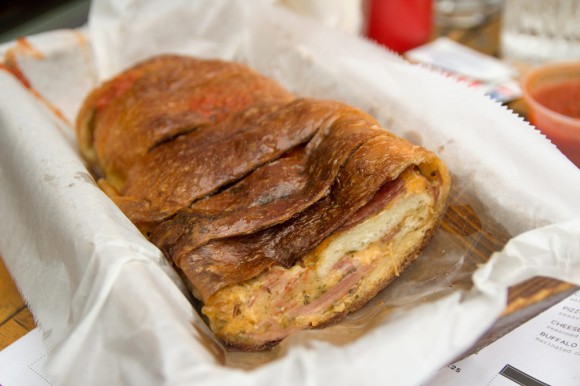
But while the Fat Jimmy is my current favorite, I’d love to see it usurped. Perhaps by the Oscar (chopped steak, bacon, peppers, grilled onions, a cheese of your choosing, and two eggs, either scrambled or over easy), or by Adrian’s Atomic Avalanche (chopped steak, American, pepperoni, hot peppers, fried mozzarella balls, and marinara), or even by the Chicken Tender Club (chicken tenders, bacon, American, chipotle mayo, lettuce, tomatoes, banana peppers, and ranch). Chopped steak, man. It’s gotten my hopes way back up.
Of course, Wogies sells more than just sandwiches. There’s garbage bread (above and above-above)—in the menu’s words, “homemade Italian bread stuffed with 3 different kinds of Italian meats and cheese”—which is great in theory, but so-so (and so goddamn salty!) in practice. And there are wings, too, which are solid, provided you stick to the ones that are sauced. (The garlic-parmesan wings are the ones in the photo below. They need sauce. Badly.) I’m decidedly not a Buffalo person, so I haven’t tried those, but I do like the honey-mustard wings, despite the fact that the “mustard” itself is, uh, candy-sweet. “Touch of natural honey,” my ass—but Wogies’ mild, creamy ranch tempers the sweetness nicely.
But if you ask me, the sides—sorry, “extras”—are where the real fun happens. (I feel this way about almost every low- to mid-tier restaurant, though, so take that statement with a grain of salt.) Ooey-gooey deep-fried mozzarella balls; solid, friendly chicken fingers; fried pickles, usually not soggy; and fries, good fries, standard or waffle, with chili, cheese, or gravy. The promise of chili-cheese fries was actually what compelled me to contact Wogies in the first place. And though these didn’t end my search—they’re no Al’s chili-cheddar fries, that’s for sure—they’re not half bad. The gravy’d waffle fries are good, too, as is everything else I listed above. Sides, man. Way, way, way overpriced, but sort of irresistible, once you’ve got that menu in your hands. Oh well.

That’s Wogies. Way too expensive to be as hit-or-miss as it is, but perversely enticing nonetheless. The Call of the Bread plays a part in this restaurant’s appeal, to be sure—but you and I both know that’s not all that keeps me orderin’. Maybe I’m a glutton for food-punishment. Maybe I’m just particularly prone to wiping underwhelming dishes from my memory. After a while, they sort of just fade away. “It wasn’t so bad,” I’ll start to tell myself And before I know it, I’m back.
That, or…I just really, really, really love going out to eat. The whole process: picking a restaurant, riding the train there, getting annoyed at all sorts of inconsequential things about the restaurant and/or the people in it, deciding what to order, waiting, grumbling about hunger, waiting, waiting, and then, best of all—yes, even better than all the chewing—that moment of inarticulable bliss that accompanies the realization that it’s not a false alarm, not this time; that the server, my server, who has nine times now walked straight past my table with an order I’ve mistaken for mine, is actually-finally-certainly approaching me, my table, not with napkins, or a pitcher, or a fun fact to share, but with whatever it is I’ve asked the kitchen to make…
Nah. It’s definitely the nut-free bread. (Which, by the way, might as well be store-bought. Totally mediocre.)
Find Wogies at 39 Greenwich Avenue, between Perry and Charles, and at 44 Trinity Place, between Rector and Edgar. I’ve only been to the former, but I can’t imagine there’d be much variation between the two.





